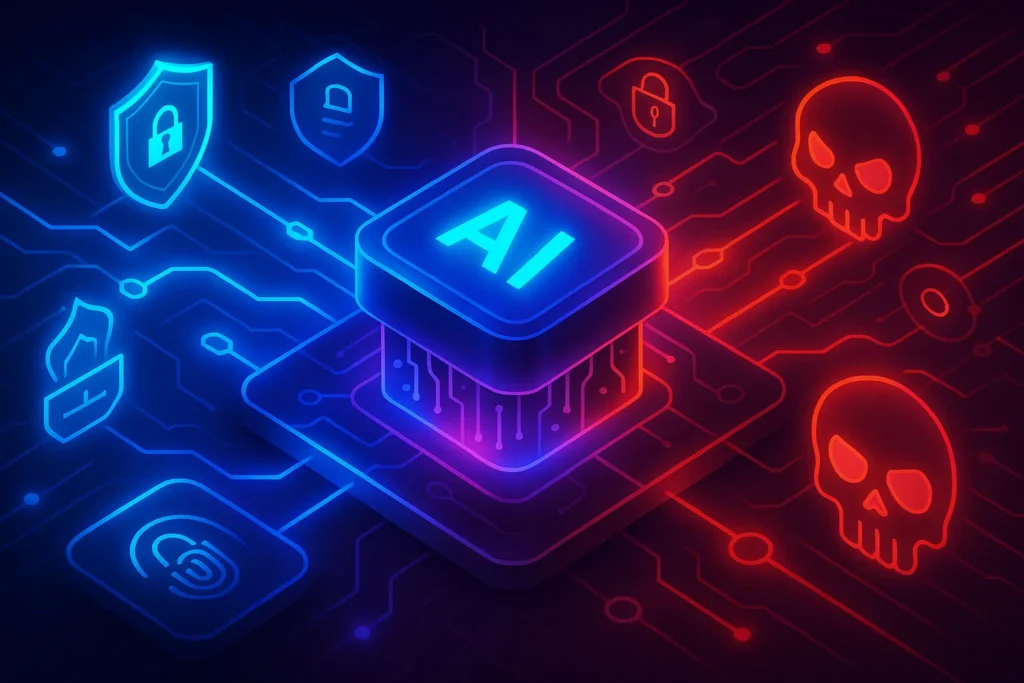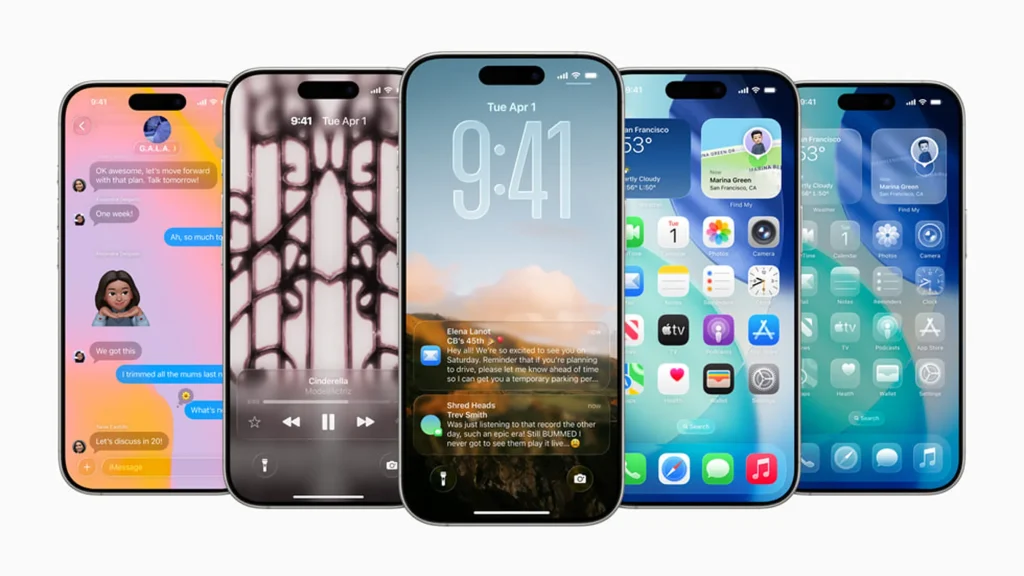-This post may contain affiliate links. If you click on one and make a purchase, I may earn a small commission at no extra cost to you.-
🌍 Introduction
In 2025, cybersecurity is being redefined by artificial intelligence—not just as a defensive tool but also as an enabler for sophisticated attacks. Organizations increasingly rely on AI-driven platforms for real-time threat detection and automated incident response. Meanwhile, cybercriminals deploy AI-enhanced malware, adaptive phishing tools, and deepfake scams that challenge conventional defenses. Staying ahead requires a balanced, intelligent strategy that leverages AI for both defense and resilience.
🧠 AI: The New Frontline in Cyber Defense
AI’s greatest value for defenders lies in its ability to autonomously recognize subtle anomalies across vast digital environments. Modern systems use machine learning to identify deviations in user behavior and network traffic, enabling instant response without human intervention. At RSA 2025, security experts emphasized how AI-powered automation is revolutionizing detection—enabling ultra-fast, accurate classification of threats and active containment of incidents.
However, integrating AI is not without challenges. These systems themselves must be safeguarded against data poisoning and adversarial manipulation. As defender technology grows more advanced, so too does the sophistication of attacks targeting AI directly.
🎯 Smarter Attacks: AI-Driven Malware and Deepfakes
Cybercriminals are adopting AI to dramatically increase the scale and impact of their attacks. Polymorphic malware powered by machine learning now evolves in real time to evade traditional defenses. According to CyberDefense Magazine, polymorphic AI malware and advanced phishing tools are rapidly proliferating.
Perhaps most ominously, generative AI is powering a surge in deepfake scams. In a striking 2025 case, a finance clerk at Arup was deceived into transferring $25 million during a video call, manipulated by AI-generated deepfakes of his colleagues. These incidents signal a critical turning point: identity-based fraud is becoming indistinguishable from reality.
⚠️ Real-World Incidents: Qantas Breach & Ransomware Surge
The AI-driven threat landscape is not theoretical—it’s already causing tangible harm. Qantas recently confirmed a vishing attack at a Manila call center that compromised personal data of six million customers (names, birth dates, phone numbers, and frequent flyer IDs). The attack, reportedly executed by the Scattered Spider group, underscores how cybercriminals exploit social engineering enhanced by AI tools.
Additionally, according to the CNC Intelligence report, ransomware incidents surged by 57% in the Asia-Pacific region in 2025, fueled by increasingly automated, AI-assisted campaigns. These trends highlight a dual threat: sophisticated attacks backed by AI, and a growing wave of ransomware hitting both corporate and public sectors.
🛡️ Defense Strategies: Proactive, AI-Aware, and Adaptive
Facing AI-empowered attacks, defenders are doubling down on AI-enabled defenses and hardened architectures. India’s Reserve Bank now mandates zero-trust security frameworks and AI-based controls for financial entities, while U.S. agencies advocate a proactive “shields-up” cybersecurity posture for critical infrastructure.
Today’s recommended security playbook includes actively learned firewalls, AI-based SOAR platforms, network deception strategies (e.g., honeypots), and continuous behavior analytics. Organizations increasingly recognize that AI-enabled offense demands AI-aware defense.
🔄 AI vs. AI: The Digital Arms Race
A defining trend in 2025 is the acceleration of AI-versus-AI cyber warfare. Estimates suggest 40–60% of breaches now involve AI-driven tactics. While attackers leverage generative models to scale reconnaissance, craft credible phishing messages, and engineer zero-day exploits, defenders work to build AI systems that anticipate and adapt—relying on explainable AI rather than inscrutable black boxes to maintain oversight.
🔍 Emerging Threats: Prompt Injection & Model Poisoning
As AI integration deepens, new forms of attacks are emerging. Prompt injection—where malicious inputs manipulate LLM behavior—is now recognized by OWASP as a top-tier risk in 2025. Even more insidious is model poisoning, which compromises AI output integrity by subtly corrupting training data—undermining trust and enabling hidden backdoors. Shockingly, fewer than half of organizations claim their staff fully understands these AI-specific vulnerabilities.
📡 What Organizations Should Prioritize in 2025
In the AI-driven threat environment of 2025, companies can no longer rely on legacy protections or annual awareness training. Defending digital infrastructure today requires a deep shift in mindset—one that combines proactive strategy, intelligent automation, and adaptive human response.
AI Governance Must Be a First-Class Priority:
The rise of generative AI inside businesses means internal tools—like chatbots, writing assistants, and even HR screening platforms—are now potential vulnerability points. Organizations need clear policies around what AI can be used for, how outputs are verified, and who holds accountability. Smart teams are creating internal “AI safety councils” that define guardrails and auditing mechanisms.
Cyber Hygiene Goes Beyond Phishing Simulations:
Traditional training isn’t enough. Teams now face deepfake meeting invites, clone voices in voicemail phishing, and even internal emails that sound “too real to doubt.” Cyber hygiene in 2025 must teach employees to trust protocol over instinct and verify all high-stakes actions through secure backchannels.
Real-Time Threat Intelligence Isn’t Optional Anymore:
Security Operations Centers (SOCs) are evolving. Instead of only detecting known threats, new platforms integrate AI-powered behavior models that predict when something’s off—before any breach happens. This includes recognizing “insider impersonation patterns,” lateral movement inside networks, or AI-generated credential stuffing.
Incident Response is the New Competitive Edge:
It’s not about if you’re breached. It’s about how fast you respond. Modern recovery plans are now AI-augmented—mapping threats in real-time, isolating affected nodes instantly, and coordinating with backup systems without delay. Businesses that test and simulate these scenarios monthly are far more resilient than those that “hope for the best.”
Vendor and Third-Party Risk Is Now Critical:
As supply chain attacks surge, leading organizations use AI to monitor vendor security posture 24/7—not just through pre-contract questionnaires. This includes:
-
Behavior anomaly tracking across shared SaaS environments
-
Tokenized data access logs that expire dynamically
-
Continuous vulnerability assessments based on external threat intel feeds
Simply put, businesses in 2025 must treat every external integration like a potential threat surface.
🛰️ What the Future Holds: From Autonomous Threat Response to AI Red Teams
As we look toward the second half of the decade, cybersecurity will no longer be a siloed IT function—it will become a core business enabler. The decisions companies make in 2025 will directly impact their operational continuity, customer trust, and compliance posture for years to come.
AI-Driven Autonomous Security Will Go Mainstream:
By 2026–2027, expect to see more widespread adoption of autonomous cyber defense systems that detect, decide, and deploy countermeasures without human input. These systems will work in milliseconds, using reinforcement learning to adapt to novel threats on the fly. Imagine firewalls that don’t just block IPs—but intelligently predict attacker behavior and adjust security rules preemptively.
AI Red Teams Will Become the New Pentesters:
Security testing will evolve. Instead of hiring human pentesters once a year, companies will deploy AI red teams—automated adversarial systems trained to breach environments using advanced evasion and mimicry tactics. These AI-driven simulations will be faster, smarter, and more relentless than anything before—offering 24/7 attack modeling based on evolving global threats.
Synthetic Identity Fraud Will Surge:
With generative models now capable of creating realistic digital personas—complete with social profiles, employment history, and even “voiceprints”—synthetic fraud is about to reach industrial scale. Companies must prepare for a wave of identity-based attacks that aren’t tied to real people, making traditional verification processes useless.
Quantum-Resistant Encryption Will Enter the Boardroom:
While quantum computers aren’t yet a direct threat, the emergence of harvest-now, decrypt-later strategies is forcing enterprises to start thinking about post-quantum cryptography. By 2025, several governments and banks are beginning migration trials for quantum-safe encryption protocols—especially for customer-facing data and long-lived records.
Legislation Will Finally Catch Up to AI Threats:
2025 also marks a turning point in cybersecurity regulation. Governments worldwide are drafting bills to regulate AI in cyber offense and defense. In the EU, proposals to classify certain AI-based cyber weapons as digital WMDs are gaining traction. In the U.S., expect new mandates around LLM auditing, attack attribution, and mandatory reporting for AI-induced breaches.
🔗 Related Read
If you’re following how major tech players are leveraging AI at scale across security and infrastructure, you’ll want to read our coverage of Big Tech’s AI Arms Race: How Google, OpenAI, and Others Are Shaping — where we unpack how giants like Google, Microsoft, and Amazon are fusing AI with next-gen security architecture.
🧠 Nerd Thoughts
Cybersecurity in 2025 feels like watching a chess game where both players are using quantum engines. On one side, AI empowers defenders with unmatched precision and speed. On the other, it gives cybercriminals the same unfair advantage. The line between “tools” and “threats” is blurring fast—and for most organizations, the question isn’t if they’ll face AI-enhanced attacks, but when.
Our advice? Don’t wait to be reactive. Build smart defenses now, stay updated on AI vulnerabilities, and treat cybersecurity like the evolving battlefield it is.
❓ FAQ
Q: What is the biggest cyber threat in 2025?
The convergence of generative AI with deepfakes and automated phishing is currently the most dangerous vector, enabling large-scale, highly convincing scams.
Q: Are AI cybersecurity tools available to small businesses?
Yes. Many security vendors now offer scalable, AI-powered threat detection and response tools designed for SMEs, including platforms like CrowdStrike Falcon, SentinelOne, and Microsoft Defender for Business.
Q: What is prompt injection in AI security?
Prompt injection occurs when malicious inputs manipulate large language models into producing unintended or harmful outputs—posing new security risks, especially in LLM-integrated apps.
Q: Can AI stop ransomware attacks?
AI can detect unusual behaviors and stop ransomware early in the execution phase—but it’s most effective when combined with strong backup strategies and zero-trust architecture.
💬 Would You Bite?
AI is reshaping cybersecurity into a high-stakes chess match—where defense and offense both use the same powerful tools.
📌 Do you feel ready for AI-powered threats? Or are deepfakes, malware-as-code, and model attacks keeping you on edge?
Share your perspective—what’s your top cybersecurity priority in this new era? 👇



